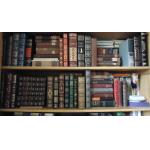
1792年 - JAMES HERVEY - MEDITATIONS AND CONTEMPLATIONS 哈维随笔名著《冥思录》3/4小牛皮豪华善本 精美原品铜版画插图 品相绝佳
¥ 2360 九五品
仅1件
北京海淀
认证卖家担保交易快速发货售后保障
作者JAMES HERVEY (詹姆斯•哈维)
出版社Coventry: printed and sold by M. Luckman
出版时间1792
版次一版一印
印刷时间1792
装帧精装
上书时间2016-06-16
- 在售商品 暂无
- 平均发货时间 42小时
- 好评率 暂无
- 店主推荐
- 最新上架
商品详情
- 品相描述:九五品
- 主要缺陷:无。因为是后世重装本,,外观可以打100分。内页稍有正常自然旧,但相对其超过220年的历史,仍然是品相超佳的精品善本书。
- 商品描述
-
1792年 - JAMES HERVEY - MEDITATIONS AND CONTEMPLATIONS 哈维随笔名著《冥思录》3/4小牛皮豪华善本 精美原品铜版画插图 品相绝佳
开本大小(长*宽*厚度):18 * 11.5 * 3.5 厘米 (34 + 372页)
装桢:3/4极品小牛皮加布面精装;皮质极好。内页完美,有正常老年斑。 精美原品铜版画插图。
品相:10品。
主要缺陷:无。因为是后世重装本,外观可以打100分。内页稍有正常自然旧,但相对其超过220年的历史,仍然是品相超佳的精品善本书。
本书是英语文学界影响极大的一部随笔名著!可以说与上古时代罗马皇帝马克•奥勒留的《冥思录》齐名,但遗憾的是,至今仍然没有中文译本!
更多图片请见 (请将下面地址复制并粘贴在浏览器地址栏中,然后再回车即可)
http://photo.163.com/chenyan383@126/#m=1&aid=303066227&p=1
作者及著作简介
Meditations and Contemplations. Containing Meditations among the Tombs: Reflection on a Flower Garden: and, a Descant on Creation. Contemplations on the Night: Contemplations on the Starry Heavens: and, A Winter-Piece.
----------------
James Hervey
----------------
Coventry: printed and sold by M. Luckman (1792), A New Edition
----------------
詹姆斯•哈维
(来自维基百科,自由的百科全书)
詹姆斯•哈维 (1714二月26-- 1758十二月25)是一位英国牧师和著名作家,著有著名的随笔集《冥思录》(Meditations and Contemplations)。
詹姆斯•哈维出生于哈丁斯顿,在北安普顿文法学校接受教育,并在牛津林肯学院。[ 1 ]在这里,他是约翰卫斯理和牛津卫理公会的影响下,特别是因为他是圣洁的俱乐部的一员。[ 2 ]最终,然而,同时保留其对于男人和他与他们的宗教目的的同情,他采取了一个彻底的加尔文信条,决心留在圣公会教堂。
有了订单在1737,他举行了几次精度,并在1752继承了他父亲在韦斯顿搞错了,collingtree家庭生活。他不强大,但是是一个很好的教区牧师和一个热心的作家。
作品
他的风格是夸张的,但他显示了一种罕见的欣赏自然的美,和他简单的虔诚使他有许多朋友。他最早的作品《冥想和沉思》[《冥思录》(Meditations and Contemplations)],十四年内出版了许多版本。大受欢迎,至今仍然被认为是英语文学史上一部经典名著。
《塞隆和阿斯巴西奥书信集》于1755出版,和同样受到了好评,给了一些不利的批评甚至从加尔文主义者,对倾向是导致反律法主义,并强烈反对卫斯理在他的保鲜剂对悬而未决的观念在宗教。除了携带进入英国的神学争议,现代神学的骨髓已经引起苏格兰(骨髓争议),这也导致了所谓的sandemanian争议的得救的信心的本质。
他的作品,一个新的和完整的版本,与一本回忆录,出版于 1797。
影响
詹姆斯•哈维通过伟大的画家和诗人威廉•布莱克有艺术持久的影响,威廉•布莱克是他的一个崇拜者。布莱克1820和1825之间画的的《詹姆斯•哈维维冥想墓葬纪》。[ 3 ]赫维也在布莱克的作品中提到的“四倍”的神圣守卫大门的人,他对布莱克的名诗 – 老虎 - 也明显产生了影响。[ 4 ]
除此之外,忧郁的扫在坟茔里他的冥想音(例如,“可怕的快乐源自凝视着倒下的纪念碑和腐朽的坟墓”)已经导致了他被尊为第十八世纪著名的“墓园诗派”( 'Graveyard School' of poets)的鼻祖,使他的工作在贺拉斯•沃波尔的“奥特朗托城堡“1764,因此具有重要的影响。后世的哥特文学和后来的浪漫主义的风格也直接的受到詹姆斯•哈维的影响和启发。[ 5 ]
James Hervey
From Wikipedia, the free encyclopedia
James Hervey (26 February 1714 – 25 December 1758) was an English clergyman and writer.
Contents [hide]
1Life
2Works
3Influence
4References
5External links
Life[edit]
He was born at Hardingstone, near Northampton, and was educated at the grammar school of Northampton, and at Lincoln College, Oxford.[1] Here he came under the influence of John Wesley and the Oxford Methodists, especially since he was a member of the Holy Club.[2] Ultimately, however, while retaining his regard for the men and his sympathy with their religious aims, he adopted a thoroughly Calvinistic creed, and resolved to remain in the Anglican Church.
Having taken orders in 1737, he held several curacies, and in 1752 succeeded his father in the family livings of Weston Favell and Collingtree. He was never robust, but was a good parish priest and a zealous writer.
Works[edit]
His style is often bombastic, but he displays a rare appreciation of natural beauty, and his simple piety made him many friends. His earliest work, Meditations and Contemplations, said to have been modelled on Robert Boyle's Occasional Reflexions on various Subjects, within fourteen years passed through as many editions.
Theron and Aspasio, or a series of Letters upon the most important and interesting Subjects, which appeared in 1755, and was equally well received, called forth some adverse criticism even from Calvinists, on account of tendencies which were considered to lead to antinomianism, and was strongly objected to by Wesley in his Preservative against unsettled Notions in Religion. Besides carrying into England the theological disputes to which the Marrow of Modern Divinity had given rise in Scotland (the Marrow Controversy), it also led to what is known as the Sandemanian controversy as to the nature of saving faith.
A new and complete edition of his Works, with a memoir, appeared in 1797. See also Collection of the Letters of James Hervey, to which is prefixed an account of his Life and Death, by Thomas Birch (1760).
Influence[edit]
Hervey had a lasting impact on art through William Blake, who was an admirer of his. Blake painted Epitome of James Hervey's Meditations among the Tombs between 1820 and 1825.[3] Hervey is also mentioned in Blake's work as one of the holy guards to the 'four-fold gate', and his influence on Blake's poem The Tyger has also been noted.[4]
In addition to this, the sombre and sweeping tone of his Meditations Among The Tombs (for example, "the dreadful pleasure inspired by gazing at fallen monuments and mouldering tombs") has led to his being placed amongst the 18th Century 'Graveyard School' of poets, rendering his work an important influence on Horace Walpole's 'The Castle of Otranto' of 1764 and consequently, the entire genre of Gothic Literature and the later Romanticism which the genre fuelled
— 没有更多了 —



























以下为对购买帮助不大的评价